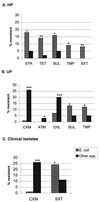A between-species comparison of antimicrobial resistance in enterobacteria in fecal flora
- PMID: 10817696
- PMCID: PMC89900
- DOI: 10.1128/AAC.44.6.1479-1484.2000
A between-species comparison of antimicrobial resistance in enterobacteria in fecal flora
Abstract
Enterobacteria in fecal flora are often reported to be highly resistant. Escherichia coli is the main species; resistance data on other species are rare. To assess the effect of the host's environment, antimicrobial resistance was determined in fecal species of the family Enterobacteriaceae from three populations: healthy people (HP)(n = 125) with no exposure to antimicrobials for 3 months preceding sampling, university hospital patients (UP) (n = 159) from wards where the antibiotic use was 112 defined daily doses (DDD)/bed/month, and geriatric long-term patients (LTP) (n = 74) who used 1.8 DDD/bed/month. The mean length of hospital stay was 5 days for the UP and 22 months for the LTP. The isolates were identified to at least genus level, and MICs of 16 antimicrobials were determined. From the university hospital, resistance data on clinical Enterobacteriaceae isolates were also collected. Resistance data for on average two different isolates per sample (range, 1 to 5) were analyzed: 471 E. coli isolates and 261 other Enterobacteriaceae spp. Resistance was mainly found among E. coli; even in HP, 18% of E. coli isolates were resistant to two or more antimicrobial groups, with MIC patterns indicative of transferable resistance. Other fecal enterobacteria were generally susceptible, with little typically transferable multiresistance. Clinical Klebsiella and Enterobacter isolates were significantly more resistant than fecal isolates. The resistance patterns at both hospitals mirrored the patterns of antibiotic use, but LTP E. coli isolates were significantly more resistant than those from UP. Conditions permitting an efficient spread may have been more important in sustaining high resistance levels in the LTP. E. coli was the main carrier of antimicrobial resistance in fecal flora; resistance in other species was rare in the absence of antimicrobial selection.
Figures
References
-
- Bonten M, Stobberingh E, Philips J, Houben A. Antibiotic resistance of Escherichia coli in fecal samples of healthy people in two different areas in an industrialized country. Infection. 1992;20:258–262. - PubMed
-
- Farmer J J. Enterobacteriaceae: introduction and identification. In: Murray P R, Baron E J, Pfaller M A, Tenover F C, Yolken R H, editors. Manual of Clinical Microbiology. 6th ed. Washington, D.C.: ASM Press; 1995. pp. 438–449.
-
- Hakanen A, Siitonen A, Kotilainen P, Huovinen P. Increasing fluoroquinolone resistance in salmonella serotypes in Finland during 1995–1997. J Antimicrob Chemother. 1999;43:145–148. - PubMed
-
- Hall R M, Collis C M. Mobile gene cassettes and integrons: capture and spread of genes by site-specific recombination. Mol Microbiol. 1995;15:593–600. - PubMed
Publication types
MeSH terms
LinkOut - more resources
Full Text Sources
Medical
Research Materials
Miscellaneous


